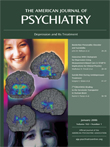A Randomized, Controlled Trial of Sequential Bilateral Repetitive Transcranial Magnetic Stimulation for Treatment-Resistant Depression
Abstract
OBJECTIVE: High-frequency left-side repetitive transcranial magnetic stimulation (rTMS) and low-frequency stimulation to the right prefrontal cortex have both been shown to have antidepressant effects, but doubts remain about the magnitude of previously demonstrated treatment effects. The authors evaluated sequentially combined high-frequency left-side rTMS and low-frequency rTMS to the right prefrontal cortex for treatment-resistant depression. METHOD: The authors conducted a 6-week double-blind, randomized, sham-controlled trial in 50 patients with treatment-resistant depression. Three trains of low-frequency rTMS to the right prefrontal cortex of 140 seconds’ duration at 1 Hz were applied daily, followed immediately by 15 trains of 5 seconds’ duration of high-frequency left-side rTMS at 10 Hz. Sham stimulation was applied with the coil angled at 45° from the scalp, resting on the side of one wing of the coil. The primary outcome variable was the score on the Montgomery-Åsberg Depression Rating Scale. RESULTS: There was a significantly greater response to active than sham stimulation at 2 weeks and across the full duration of the study. A significant proportion of the study group receiving active treatment met response (11 of 25 [44%]) or remission (nine of 25 [36%]) criteria by study end compared to the sham stimulation group (two of 25 [8%] and none of 25 respectively). CONCLUSIONS: Sequentially applying both high-frequency left-side rTMS and low-frequency rTMS to the right prefrontal cortex, has substantial treatment efficacy in patients with treatment-resistant major depression. The treatment response accumulates to a clinically meaningful level over 4 to 6 weeks of active treatment.



